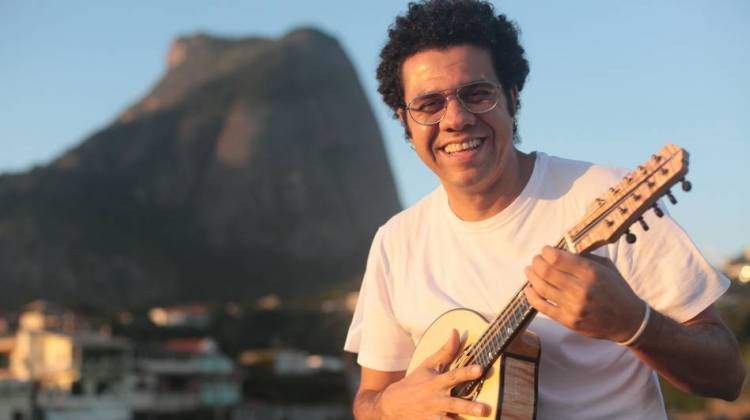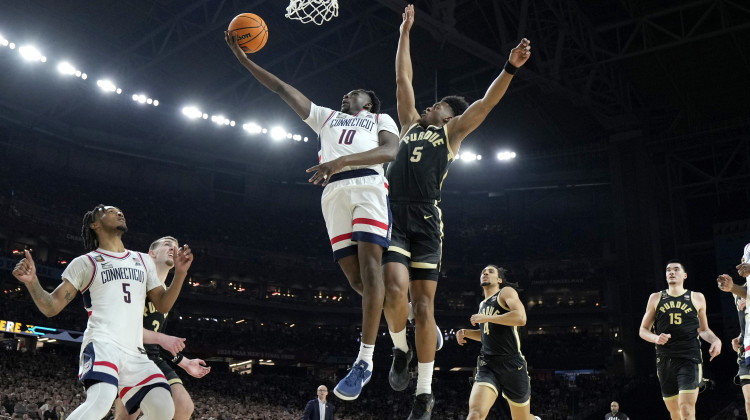Alfredo Viana was one of the superstars of the Brazilian musical style known as choro. The flautist and saxophonist, better known by the nickname Pixinguinha, pushed the boundaries of choro by incorporating jazz and ragtime into his compositions.
Hamilton de Hollanda explores that connection on the new album Mundo de Pixinguinha — that is, "The World of Pixinguinha." The Brazilian recorded with Cuban pianist Chucho Valdés, French accordionist Richard Galliano, and American trumpeter Wynton Marsalis.
"As I've traveled around the world in the past 10 years, I became friends with a few musicians and I recorded with a few of them," de Holanda says. "I thought it would be an opportunity for the music of Pixinguinha to be played by jazz musicians who know about improvisation, and who know how to interpret music that's not theirs."
De Hollanda plays an instrument called the bandolim. It evolved from the mandolin, brought to Brazil by Portuguese colonizers, and its acknowledged master was a man named Jacob do Bandolim. De Holanda says do Bandolim's genius lay in his ability to blend music brought by the Portuguese with that of African slaves to create a perfect balance.
"He created a Brazilian way, with a lot of emotion," he says. "You hear in his music a little bit of the fado nostalgia, but also the joy of Brazilian music, and African music too — and with such care in the refinement of a sound and the arrangements."
But de Holanda wanted to take the music further — and he does, says Sergio Mielniczenko. He's the producer and host of The Brazilian Hour, a radio program distributed across the U.S. and around the world.
"He's a musician with an incredible technique and a deep interpretation to the soul of Brazilian music," Mielniczenko says of de Holanda. "If you look at his repertoire, he plays everything from Jacob do Bandolim to Egberto Gismonti to Hermeto Pascoal — and more recently he has been pairing with very outstanding musicians as well. But that's what is interesting about Hamilton: You cannot see him as a choro composer, only. Obviously he plays choro, but he's beyond."
De Holanda plays a special kind of bandolim. Normally, the instrument has eight strings, just like the mandolin. De Holanda had one built with 10 strings.
"I wanted to create a polyphony in my instrument, and be able to play the melody, the accompaniment and the rhythm, all at the same time," he says. "Just as you see in a piano soloist or a guitar soloist, I wanted to express some polyphonic ideas in the bandolim — the same way a piano works in a jazz trio."
De Holanda's ideas about what the bandolim can do led him to collaborate with a pianist, Italian Stefano Bollani, for another recent recording, O Que Será.
"The Bandolim has certain musical 'off-keys.' The piano is always perfectly in tune. Perhaps the defect of the bandolim," de Holanda says, "is that when it's paired with a piano, magic is born, which is something I cannot explain."
De Holanda says though he started out playing choro, he's emphatic about where he's taking the music.
"What I'm doing today is not exactly choro, it's not only samba, and it's not just jazz. It's all of the above, the confluence of all of it," he says. "Out of all that is the music of Hamilton de Holanda."
It's safe to say Pixinguinha would approve.
9(MDEwMDc1MzM3MDEzNDczOTA0MDc1MzViMQ001))
 DONATE
DONATE








 View More Programs
View More Programs

 Support WFYI. We can't do it without you.
Support WFYI. We can't do it without you.